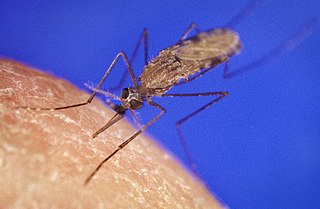
Extinction is the termination of a kind of organism or of a group of kinds (taxon), usually a species. The moment of extinction is generally considered to be the death of the last individual of the species, although the capacity to breed and recover may have been lost before this point. Because a species' potential range may be very large, determining this moment is difficult, and is usually done retrospectively. This difficulty leads to phenomena such as Lazarus taxa, where a species presumed extinct abruptly "reappears" after a period of apparent absence.

The Tipulomorpha are an infraorder of Nematocera, containing the crane flies, a very large group, and allied families.

The Culicomorpha are an infraorder of Nematocera, including mosquitoes, black flies, and several extant and extinct families of insects.

The Bibionomorpha are an infraorder of the suborder Nematocera. One of its constituent families, the Anisopodidae, is the presumed sister taxon to the entire suborder Brachycera. Several of the remaining families in the infraorder are former subfamilies of the Mycetophilidae, which has been recently subdivided. The family Axymyiidae has recently been removed from the Bibionomorpha to its own infraorder Axymyiomorpha.
Neontology is a part of biology that, in contrast to paleontology, deals with living organisms. It is the study of extant taxa : taxa with members still alive, as opposed to (all) being extinct. For example:

The Darwin Region languages are a small family of poorly attested Australian Aboriginal languages of northern Australia proposed by linguist Mark Harvey. It unites the pair of Limilngan languages with two language isolates:
Anomalomyidae is a family of extinct muroid rodents from Europe.

Meleagridinae is a North American subfamily of birds in the family Phasianidae. It includes turkeys and their extinct relatives.
The Early Miocene is a sub-epoch of the Miocene Epoch made up of two stages: the Aquitanian and Burdigalian stages.

A species that is extinct in the wild (EW) is one that has been categorized by the International Union for Conservation of Nature as known only by living members kept in captivity or as a naturalized population outside its historic range due to massive habitat loss.

The Alligatorinae comprise one of two subfamilies of the family Alligatoridae. Ten genera in this subfamily are described, but only one is extant.

Several extinct species have been postulated, but owing to a lack of evidence they can only be regarded as hypothetical extinct species. They have caused confusion, as they may have been a separate species, a subspecies, an introduced species or a misidentification.
Protochelydra zangerli is an extinct species of chelydid in the extinct genus Protochelydra of Chelydridae.

The Braque Dupuy, also known as the Dupuy Pointer, was a breed of pointer from the Poitou region of France, it is believed to be extinct.
Wangerooge Frisian is an extinct dialect of the East Frisian language, formerly spoken on the East Frisian island of Wangerooge. Wangerooge Frisian was a part of the Weser group of dialects which included the Wangerooge and the equally extinct Wursten dialect. The last speaker died in 1953.
Ware is an extinct Bantu language near Lake Victoria in East Africa.

Megalochelys is an extinct genus of cryptodiran tortoises that lived from the Miocene to Pleistocene, across Asia and possibly Eastern Europe. They are noted for their giant size, which is among the largest of any known testudine, with a maximum carapace length over 2 m in M. atlas.
Llaqta Qulluy is an archaeological site in Peru on a mountain of that name. It is situated in the Huancavelica Region, Huancavelica Province, Conayca District. The predominantly circular walls of Llaqta Qulluy are situated at a height of about 3,400 m (11,200 ft).
Llaqta Qulluy is an archaeological site in Peru on a mountain of that name. It is situated in the Huancavelica Region, Tayacaja Province, Ahuaycha District. The site lies in the community of Llaqta Pata (Llaccta Pata), Vista Alegre, on top of the 3,960-metre-high (12,990 ft) mountain.
Llaqta Qulluy is an archaeological site in Peru. It is situated in the Huancavelica Region, Huancavelica Province, Acoria District.










